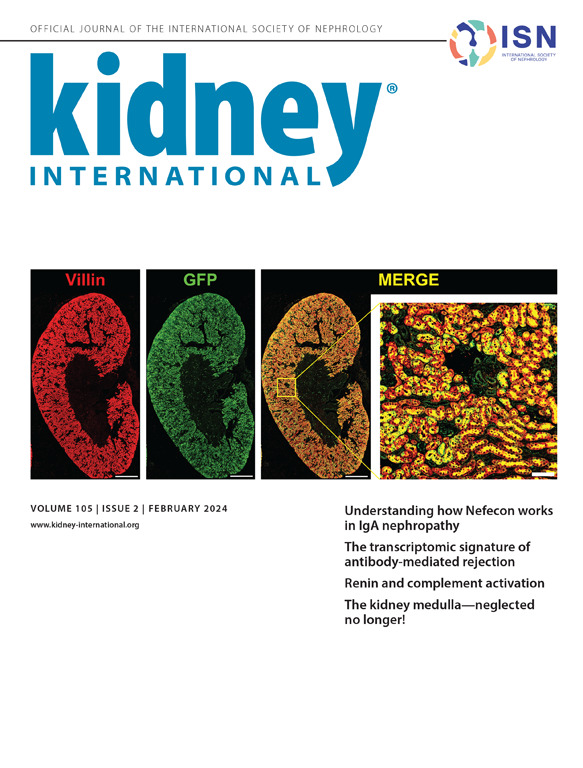A分解素和金属蛋白酶10 (ADAM10)对足细胞表面蛋白的调控。
IF 14.8
1区 医学
Q1 UROLOGY & NEPHROLOGY
引用次数: 0
摘要
足细胞是肾滤过屏障的终末分化细胞。它们交错的足突网络包含肾小球毛细血管,并可能通过足细胞表面蛋白的分裂而重塑。金属蛋白酶ADAM10是这种表面蛋白脱落的主要调节因子,最近被认为与抗体介导的足细胞损伤的病理生理学有关。方法研究ADAM10在足细胞健康和疾病生物学中的作用,详细分析足细胞膜蛋白的显著表达及与疾病相关的蛋白。我们使用基因缺陷小鼠,adam10抑制猪肾小球,以及各种体外实验系统,其中进行了详细的生化和成像技术。结果我们发现血小板反应蛋白1型结构域含有7A (THSD7A)和磷脂酶A2受体1 (PLA2R1),这两种抗原都是原发性膜性肾病抗原,在ADAM10抑制/缺乏时积累。此外,足突黏附蛋白β-糖酐(β-DG)蛋白水平升高。在不同的实验系统中详细的生化分析表明,THSD7A、PLA2R1和β-DG是真正的ADAM10底物,并受到γ-分泌酶介导的膜内蛋白水解。这些底物在足细胞中共定位并与蛋白酶相互作用,它们的脱落调节丝状发育(THSD7A和β-DG)和细胞基质粘附(β-DG)。ADAM10底物的使用,以及足细胞表面蛋白的稳定性,都受到四跨蛋白(Tspan) 15的调控,同样存在于足细胞足突中。发现THSD7A/ADAM10/Tspan15的三组分复合物,THSD7A同时作为ADAM10底物和调节物。总之,我们的数据强调了ADAM10/ tspan15介导的足细胞足突表面蛋白调控的重要性,这些蛋白在原发性膜性肾病中作为抗原并影响细胞骨架动力学。本文章由计算机程序翻译,如有差异,请以英文原文为准。
Regulation of podocyte surface proteins by the enzyme A Disintegrin And Metalloproteinase 10 (ADAM10).
INTRODUCTION
Podocytes are terminally differentiated cells of the kidney filtration barrier. Their network of interdigitating foot processes embraces the glomerular capillaries and are likely remodeled by cleavage of podocyte surface proteins. The metalloproteinase ADAM10 is a major regulator of such surface protein shedding and was recently implicated in the pathophysiology of antibody-mediated podocyte injury.
METHODS
Here, we studied the contribution of ADAM10 in podocyte biology in health and disease and analyzed prominently expressed and disease-relevant podocyte membrane proteins in detail. We used genetically deficient mice, ADAM 10 inhibited pig glomeruli, and various in vitro experimental systems where detailed biochemical and imaging techniques were performed.
RESULTS
We found that thrombospondin type 1 domain containing 7A (THSD7A) and phospholipase A2 receptor 1 (PLA2R1), both of which are primary membranous nephropathy antigens, accumulated upon ADAM10 inhibition/deficiency. Moreover, increased proteins levels of the foot process adhesion protein β-dystroglycan (β-DG) were found. Detailed biochemical analyses in different experimental systems revealed that THSD7A, PLA2R1, and β-DG are true ADAM10 substrates and subject to γ-secretase-mediated intramembrane proteolysis. These substrates co-localize and interact with the protease in podocytes and their shedding regulates filopodogenesis (THSD7A and β-DG) and cell matrix adhesion (β-DG). ADAM10 substrate usage, but also the stability of the podocyte cell surface proteins, are regulated by tetraspanin (Tspan) 15, which is likewise present at podocyte foot processes. A tricomponent complex of THSD7A/ADAM10/Tspan15 was found, with THSD7A acting as both an ADAM10 substrate and regulator.
CONCLUSIONS
Altogether, our data emphasizes the importance of ADAM10/Tspan15-mediated regulation of podocyte foot process surface proteins that serve as antigens in primary membranous nephropathy and impact cytoskeletal dynamics.
求助全文
通过发布文献求助,成功后即可免费获取论文全文。
去求助
来源期刊

Kidney international
医学-泌尿学与肾脏学
CiteScore
23.30
自引率
3.10%
发文量
490
审稿时长
3-6 weeks
期刊介绍:
Kidney International (KI), the official journal of the International Society of Nephrology, is led by Dr. Pierre Ronco (Paris, France) and stands as one of nephrology's most cited and esteemed publications worldwide.
KI provides exceptional benefits for both readers and authors, featuring highly cited original articles, focused reviews, cutting-edge imaging techniques, and lively discussions on controversial topics.
The journal is dedicated to kidney research, serving researchers, clinical investigators, and practicing nephrologists.
 求助内容:
求助内容: 应助结果提醒方式:
应助结果提醒方式:


